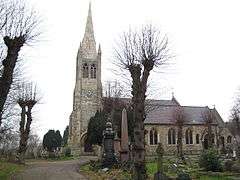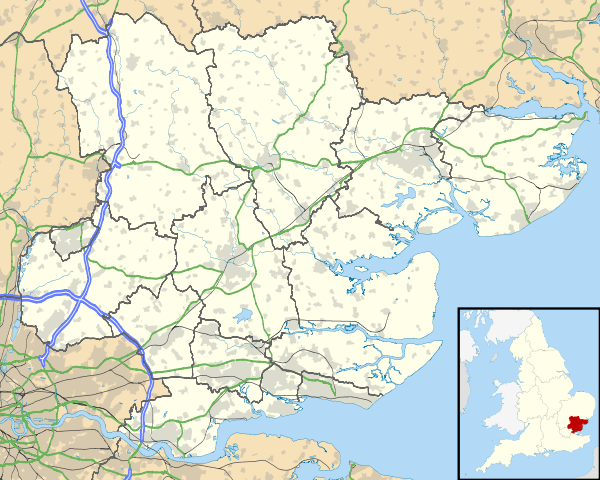Buckhurst Hill
Buckhurst Hill is a town in the Epping Forest district of Essex, England. Part of the metropolitan area of London and the Greater London Urban Area, it is adjacent to the northern boundary of the London Borough of Redbridge, around 10 miles (16 km) north-east of Charing Cross. The area developed following the opening of a railway line in 1856, originally part of the Eastern Counties Railway and now on the Central line of the London Underground.
| Buckhurst Hill | |
|---|---|
 The parish church of St John the Baptist, built in 1838 | |
 Buckhurst Hill Location within Essex | |
| Population | 11,380 (2011)[1] |
| OS grid reference | TQ415935 |
| • London | 10 mi (16 km) SW |
| Civil parish |
|
| District | |
| Shire county | |
| Region | |
| Country | England |
| Sovereign state | United Kingdom |
| Post town | BUCKHURST HILL |
| Postcode district | IG9 |
| Dialling code | 020 |
| Police | Essex |
| Fire | Essex |
| Ambulance | East of England |
| UK Parliament | |
| Website | Buckhurst Hill Parish Council |
History
The first mention of Buckhurst Hill is in 1135, when reference was made to "La Bocherste", becoming in later years "Bucket Hill", originally meaning a hill covered with beech trees.[2] It lay in Epping Forest and consisted of only a few scattered houses along the ancient road from Woodford to Loughton. Before the building of the railways, Buckhurst Hill was on the stagecoach route between London and Cambridge, Norwich, Bury St Edmunds and Dunmow. Originally it was a part of the parish of Chigwell; there was no road connecting the two communities and in order to get to church, parishioners had to ford the River Roding at Woodford.[3] The Parish Church of St John was built in 1838 as a chapel of ease but Buckhurst Hill did not become a separate ecclesiastical parish until 1867.[4] St John's National School was also built in 1838. The lord of the manor gave a site next to the church; the building cost £209, most of which was donated by the church congregation.[5] The opening of Buckhurst Hill station in 1856 saw a rapid expansion in the population of the area; nearly six hundred new houses had been built near the station by 1871, leading to the opening of the Prince's Road school in 1872. Some of the land for this expansion was enclosed from Epping Forest, before this practice was halted by the Epping Forest Act, 1878.
The civil parish of Buckhurst Hill became Buckhurst Hill Urban District in 1894. In 1933, it was merged with the Chigwell and Loughton Urban District to form the Chigwell Urban District.[6] A further merger with Epping Urban District, Waltham Holy Cross Urban District and most of Epping and Ongar Rural District in 1974 brought Buckhurst Hill into Epping Forest District,[7] and in 1996, Buckhurst Hill Parish Council was established as a first tier of local government.[8]
Geography
It is at the western edge of Essex, 10.7 miles (17.2 km) northeast of Charing Cross and bordering the London Borough of Redbridge. Parts of Epping Forest in Buckhurst Hill are intermingled with residential areas.
Transport
Buckhurst Hill is served by two London Underground stations: Buckhurst Hill (in London fare zone 5) and Roding Valley (in London fare zone 4), which are on the Central Line. The line directly links the area to central London, as well as local areas including Woodford, South Woodford, Leytonstone, Epping and Loughton. Also, from nearby Chingford station, services can be used to reach London Liverpool Street via Walthamstow and Hackney. Bus service 397 can be used to reach Chingford station. Most bus routes serving Buckhurst Hill are London Buses services (despite being outside the London Buses zone).
Sport

Loughton Rugby Union Football Club has its clubhouse and pitches on Hornbeam Rd at the south of the town. Buckhurst Hill Football Club is on Roding Lane at the east of the town.
Buckhurst Hill Cricket Club plays in the Shepherd Neame Essex League, and fields four Saturday XIs, two Sunday XIs, and teams in a junior section. The club plays at two cricket fields: one off Roding Lane at the east of the town; and one at the edge of Powell's Forest (part of Epping Forest), off High Road at the north of the town.
Education
Buckhurst Hill schools include St John's, a CofE, (Church of England) school and Whitebridge Primary School.
Media
Buckhurst Hill was featured on the ITV1 series Essex Wives, a programme about women in the area who were in business or fairly well-off. Filming for The Only Way Is Essex takes place at a beauty salon in Queens Road.
Notable people
- Sir William Addison (1905–1992) – historian and author, lived at Buckhurst Hill and owned a bookshop in Loughton[9][10]
- Richard Crossman, Labour politician, grew up in Buckhurst Hill [11]
- Daniel Mays, actor, grew up in Buckhurst Hill
- Jack Straw, Labour politician, was born in Buckhurst Hill
- Dick Turpin moved to Buckhurst Hill in 1725.[12]
Nearest places
References
- "Town population 2011". Neighbourhood Statistics. Office for National Statistics. Archived from the original on 18 October 2016. Retrieved 1 September 2016.
- Reaney, Percy Hide (10 June 2017). "The Place-Names of Essex". The University Press – via Google Books.
- [A History of the County of Essex: Volume 4: Ongar Hundred. W R Powell (Editor), 1956 (pp 18–22) http://www.british-history.ac.uk/report.aspx?compid=15534]
- "Chigwell: Churches - British History Online". www.british-history.ac.uk.
- "Chigwell: Schools - British History Online". www.british-history.ac.uk.
- "Chigwell: Introduction - British History Online". www.british-history.ac.uk.
- "Epping Forest District Council: History of the District". Archived from the original on 6 June 2010. Retrieved 14 June 2010.
- "BUCKHURST HILL PARISH COUNCIL - About Buckhurst Hill". www.essexinfo.net.
- Kneale, Kenneth (1992); Essex Heritage, Leopards Head Press, pp.3-14. ISBN 0904920232
- Morris, Richard; "Sir William Addison (1905-1992) – a retrospective" in Loughton and District Historical Society: Newsletter 165, March/April 2005, pp.3-5
- Winchester College, A Register, 1974, page 108
- https://hauntedpalaceblog.wordpress.com/2013/04/20/dick-turpin-boudica-hangmans-hill-and-the-suicide-pool-tales-from-epping-forest/
External links
- Population figures
- Buckhurst Hill Cricket Club
